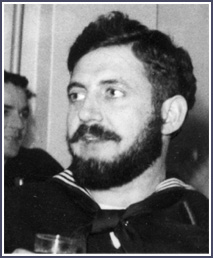
Oral Historian: Carl Ellis HoltInterview Date: 16 February 2007Interviewer: John BowersWhen did you go in the Navy?In 1942 - August 1942. Did you volunteer or were you drafted?I volunteered, but I probably would have been drafted before too long anyway. What made you decide on the Navy?I don't know - I've always been a boat person. I just like the sea. Were you ever disappointed that you chose the Navy and wished you were somewhere else?Probably yes… (laughter) Where did you do your boot training, Carl?At Great Lakes, Illinois. What do you remember about boot training --- what was the best thing, what was the worst thing?The worst thing was the weather up there. It didn't snow…it snowed up and down and it snowed sideways. When we left Great Lakes and went to San Diego, the weather in Great Lakes was nasty. When we went to San Diego, we went around in short sleeves. What kind of training did you take after you finished your boot camp?I had 17 weeks at Great Lakes, Illinois, and took gunner's mate training. Then I went to San Diego, and I had advanced hydraulic training out there. I think I was there about three months or something like that. You told me that back in boot camp that you all slept in hammocks? What was interesting about the hammocks?They were good to sleep in when you got used to them, but it was awful easy to get dumped out. Now you didn't dump anyone out, did you?Oh, yes, probably every night. You either dumped or got dumped. (Laughter) So you took gunner's mate training and hydraulic training. Where did you go after that?We went to Seattle, Washington, and went aboard the new construction, USS Thompson, DD627. 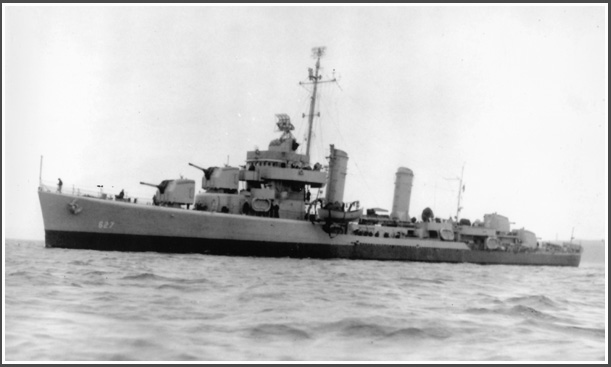 The USS Thompson (DD627)
And that's a tin can - what's a tin can?Yes, I think the metal is maybe an eighth of an inch thick. So it doesn't take much to knock a hole in it. Was that a destroyer?Yes. That was probably made from some of that recycled metal that the school kids were collecting?Probably. And aluminum cans…There was probably a lot of tin in it. So here you are on the West Coast, and you finally have joined a new ship…I guess it was built out in Seattle at the shipyards?Yes, Seattle-Tacoma shipyards And then what happened after that?We came around to the East Coast and joined the Atlantic Fleet. And to get to the East Coast, it's kind of a long route. What is that route?We came through the Panama Canal. I guess it was at least 7 or 8 thousand miles. Was it interesting to go through the Panama Canal?Oh, it was fascinating! I liked that! Kind of warm down there, wasn't it?Oh, yeah! I think it rained about every day down there. Well, I think it would be better to go through it on a ship than trying to build it - they seemed to have a few problems when they built it.I think so! So you came around to the East Coast - and what happened then?They have an island up off New England that used for gunnery practice. We went up there and practiced a little bit. We shot a few 5 inch rounds, 40 mm - anything we had, we could try it out, you know. Now the 5 inch was a ship-to-shore gun, wasn't it?Well, it was either shore or aircraft - they were anti-aircraft guns, too. 5 inch 38s. How about that 40 mm, what was that?The only difference between a 20 mm and a 5 inch is that it's smaller than a 3 inch. They are usually a two-gun mounts or a 4-gun mounts. Were you a gun chief - in charge of a gun?Yes, part of the time. Part of the time 5 inch, then 3 inch - most of the time I had a 20 mm battery. And a searchlight right in the middle of our gun mounts, you know. After you all finished your shakedown cruise, where did you go next?We ran, I think, three convoys: one of them to Casablanca, one to Oran, and one to Naples, Italy. You didn't see Humphrey Bogart down in Casablanca, did you?You know, Humphrey Bogart made the movie, "The Caine Mutiny." They made it on our ship, you know. I don't know what year it was… It was after the war?Yeah Ok, you went to Casablanca and ran these convoys. Did you have any trouble with German U-Boats?We didn't lose a ship, but the convoys have a rule that if a ship goes down, you give them so many hours to get going again. If it couldn't get going again, they just wished them well and told them good bye/ And then he was pretty much a sitting duck if a U-Boat came along, right?Oh, yeah. Did you run into any mine fields out there in the ocean during these convoys?No, not out there. We had a German plane that almost flew into us off of Omaha (Beach). I think he was laying mines. That was after D-Day, wasn't it?Yes, a day or two after… Tell me about preparations before D-Day. What did you all do?Well, mainly we had a lot of gunnery practice. Now were they flying airplanes by, towing a sleeve, and you all would shoot at that? What did you shoot at?We shot at a sleeve some. Did it make the pilots nervous?(Laughter) … We've had one of the ship in the convoy shoot the thing down … cut the tow rope, you know. Nobody got hurt, though. Nobody got hurt? That's the good news! So, you all did that kind of preparation, and then June 6th, the weather had really been bad. And then you kind of got an opening in the weather, I understand.Yeah, I think they were planning to go on June 4th and they put it off a day or two. So what was your ship's mission on D-Day?We were going up and down the coast just hitting anything that …see most of the time some targets were assigned and some you'd sight them and take a shot at them. So shore bombardment facilities…They had the commandos going up the cliff, and I think I told you before that I don't know how they got their cable up there first. But they were just going up those things like a monkey up a tree. Which beach was that?Omaha That was the hardest beach - they took the most casualties there.I think so. They said that some of the placements had not been destroyed very well.We saw three of those LSTs with troops on them just hit…1-2-3…you know. That's terrible. So that's when you saw the plane trying to seed the mines…was during D-Day or thereafter?That was two or three days later. But anyway, he almost flew into us. Actually I don't know whether we got him - there were three ships shooting at him. We got credit for it-we didn't deny it, you know. I've got a picture here that was drawn by one of your shipmates. He was talking about what mines look like in day and at night. At day he shows a mine floating in the water with a few spikes sticking out. At night, it's just pitch black, and you can't see anything. "When a mine looks like on a night like this, if you see anything that you can't see, just report it at once!" So he had a sense of humor. And then he had another cartoon panel where he showed what it looks like in your imagination. There's this HUGE mine in front of the ship.That's what it looked like to the Captain, you know. And to a gunner crew like you, there shows a 20 millimeter shooting at it, and it looks like a fly speck down there shooting at this gun.We fired at and sunk two or three mines like that. Blew them up, you know, but not a whole lot. 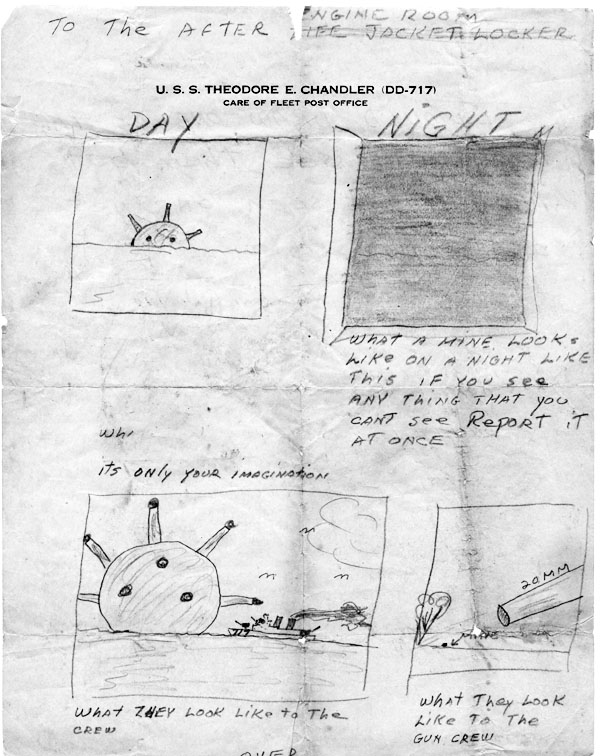 Cartoon drawn by one of Carl Holt's shipmates circa 1945.
The last thing he said on the back of this sheet of this paper was, "I would draw one as the lookout seeing one, but they haven't seen one yet, so that's impossible." (Laughter) … That was pretty good.So did you all take any casualties on your ship during the Normandy invasion?No. When did you get out of the Navy?I think it was January 13th or 15th or something like that of 1946. You were a Gunner's Mate first Class. You had the European-African Theater with two stars. You had the Asiatic-Pacific Theater, and the American Area, the Victory Ribbon, and the Good Conduct Medal. How did you get the Good Conduct Medal, Carl?Just lucky, I guess. (Laughter) And the point system…Now when you got out of the Navy in 1946 and came back to this area, where did you work then?I worked at Camp Lee for awhile. I forget the name of the outfit down there then. And then I had probably a half dozen jobs around town. You were telling me something about the 52 - 20…or 20 -52…Oh, the 52-20 during WWII - when you got out and weren't in a hurry to go to work, you could draw $20 for 52 weeks. And a lot of people did that. Back in those days you could live on $20 a week. And so you didn't go to work right away?No, I didn't go there. I was afraid I'd get in too much of a habit of it and wouldn't want to go back to work. Now your Navy career wasn't over at that point. A little later, we had this Korean conflict - what happened then to you?Well, I was called back. You didn't volunteer to go, they just called you?I had a wife and kid, and I probably could have gotten out if I'd pushed it, you know. But I wanted in. That time you were on a different kind of ship - what was it?Well, it was a destroyer, but it was a bigger destroyer. Instead of seven 5-inch mounts, they had 3 double 5- inch mounts. And you were still a gunner's mate?Yes. And then you all crossed the International Dateline, but that was back in 1945 when you did that.Yes, I think so. In '45, I got off the ship in Okinawa. I kind of believe we came back across the dateline on Christmas Day - I'm not sure. I've got a Sacred Order of the Golden Dragon here - that's what that is, isn't it?Yes 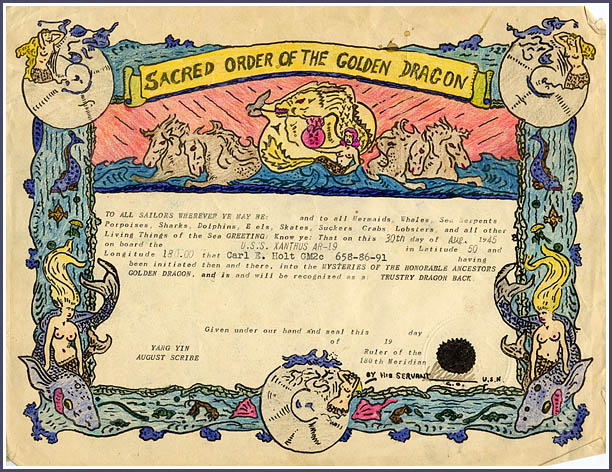 Carl's Golden Dragon Award for crossing the International Dateline
It said you did it on the 25th of August 1945, the USS Xanthus?Yes, that was the last ship I was on during WWII. It was a repair ship. We went into the Japanese Occupation on that ship. I think September 8th or 9th…something like that. So you were in the harbor - where in Japan were you?They called it a secondary naval base; it was on the main island but up on the northern end of the island. You didn't see General MacArthur. did you?No, I missed him. I got to be shipmates with Eisenhower a little bit anyway. Tell me about that?I think it was the 12th of June. We took MacArthur and two or three of the Admirals to France for two trips - they just went over to run around. They probably didn't get too close to the front lines, I guess. I think it is interesting to note that your ship, the Thompson, later on in Korea did get hit by shore fire several times and took some casualties. Hit the bridge and fire control.Yeah, they got hit and I forget how many casualities they had now, but a year later they got hit at just about the same place. Well, the first time, according to the newspaper you've got here, one shell hit a bridge, knocking out fire control, killing three. That was in 1951. It said she destroyed one enemy shore battery and damaged another, and then she came back and got fixed up. In June, she was back there again and was again doing coastal gunfire and got hit by a Chinese battery. It hit her flying bridge, killing 4 and wounding 9. So she finally had a lot, and she was hit again later on in Wonsan Harbor, so she took a lot. But it was an interesting thing. Most of those ships had been decommissioned.The Thompson, I think, was sold for scrap in 1972 or 1973. Nobody thought anything about it at the time, but when they scrapped it, I wished they'd had like a nameplate on the ship, you know, behind the bridge? I wished that somebody had gone on the ship and taken it off for a souvenir. Sometimes when they decommission something like that, they'll do exactly that. They'll take the ship's bell and a nameplate like that, and they'll put them in storage somewhere in a warehouse.OK, you've certainly had an interesting career, Carl. Thank you!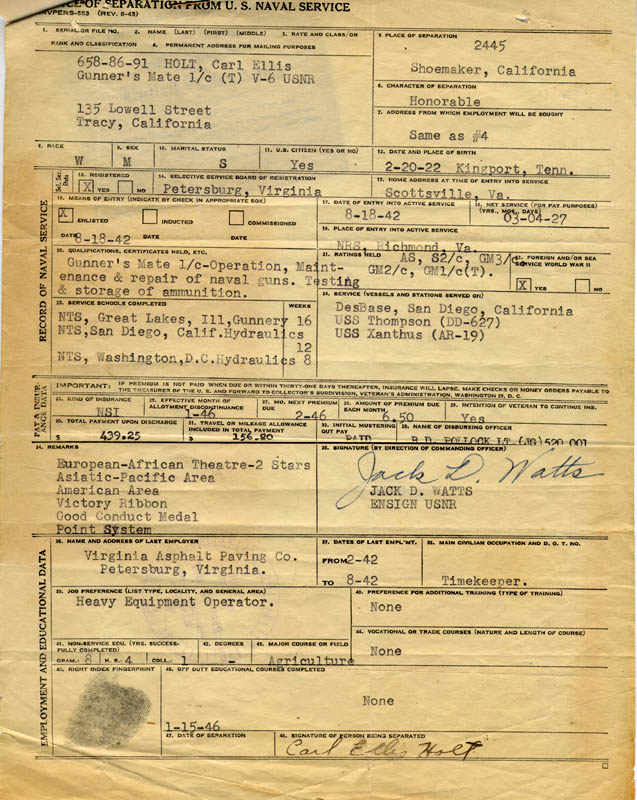 Carl Holt's Separation Papers from the U.S. Navy, 15 January 1946
|